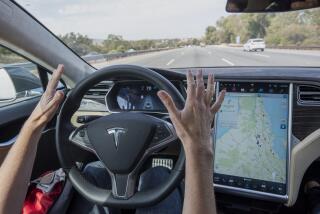Coalition Targets Youths’ ATV Use
- Share via
Last Thanksgiving, when more than 240,000 people arrived for a weekend of camping, partying and riding dune buggies and all-terrain vehicles at the Imperial Sand Dunes Recreation Area near El Centro, Calif., the emergency room at Pioneer Memorial Hospital was swamped.
“It was a madhouse,” said Dr. Michael Berger, director of the hospital’s emergency department.
Close to 160 patients a day--most of them injured in ATV- related accidents--flooded the small hospital in Brawley, he said.
“Beer, gasoline and ATVs” are a dangerous mix, Berger said. “I’ve seen so many severe traumas and injuries that it’s all a blur.”
Amid the stream of broken bones, scrapes and head injuries that holiday weekend, Berger recalls the death of a child who was riding on the back of an ATV driven by his father. The father suffered a broken collarbone; the little boy, a broken neck.
Troubled by the surge of ATV- related injuries and deaths of children, a coalition of medical, consumer and environmental groups is calling for a federal inquiry into ATV safety.
The coalition has called on the government to prohibit children younger than 16 from riding powerful full-size models of the four-wheeled, motorcycle-derived vehicles. The member groups also advocate federal or state training and licensing standards for all ATV users.
Most injuries to children riding ATVs occur on adult-size models, a recent study by the U.S. Consumer Product Safety Commission determined.
Some members of the coalition, including the Consumer Federation of America and the American Academy of Pediatrics, say they would prefer a rule that goes further, barring children under 16 even from so-called child-size ATVs.
ATV enthusiasts and industry representatives oppose such regulations. They maintain that most drivers engage in safe and responsible use of the vehicles.
Elisabeth Piper, director of corporate affairs for the Specialty Vehicle Institute of America, an ATV trade group, blames accidents on a minority of users who disregard safety rules and allow their children to drive or ride adult-size ATVs.
“We don’t believe children should be riding adult vehicles,” Piper said. Her group urges ATV buyers to attend its free training programs and to restrict their children to riding the less powerful ATVs designed for young riders.
Unfortunately, Piper said, only about 25% of all new buyers of ATVs in the U.S. take advantage of the training sessions.
In the last 20 years, there have been 4,541 ATV-related deaths nationwide, the Consumer Product Safety Commission report said. California, a major ATV market, led the nation with 278 of those fatalities.
The numbers have risen each year, the commission found, as the popularity of ATV riding has skyrocketed. Annual sales of ATVs jumped from 368,000 in 1997 to 825,000 in 2001 and are continuing to climb this year, the commission said. As many as 7 million ATVs are in use today, according to the Natural Trails and Waters Coalition, which works to protect public lands and waters from damage caused by off-road vehicles.
Particularly disturbing is that 38% of those killed in ATV accidents have been children younger than 16. More than 800 of those children, 18% of the total ATV deaths, were under 12.
Last year alone, nearly 35,000 youngsters under 16 received emergency treatment for ATV- related injuries, said Dr. Gary Smith, director of the Center for Injury Research and Policy at Children’s Hospital in Columbus, Ohio, one of the organizations petitioning the product safety commission for tougher ATV regulations.
All new ATVs are four-wheeled vehicles. The less-stable, three-wheeled models haven’t been marketed since the late 1980s, when they were associated with a increase in injuries. But three-wheeled ATVs remain in use.
The safety coalition wants ATV makers to buy back those three-wheelers and to offer refunds to people who bought full-size ATVs for use by children under 16.
“Self-regulation by the ATV industry has led to larger and faster ATVs and more children being killed and injured,” said Rachel Weintraub, a lawyer for the Consumer Federation of America.
There was a time when the Consumer Product Safety Commission regulated the ATV industry. The industry challenged the commission’s authority in a lawsuit that resulted in the production ban on three-wheeled vehicles and ended the regulations.
Representatives of the safety coalition contend that because ATVs today are faster (some can travel 75 mph) and bigger (weighing up to 550 pounds), they can be difficult for children to control.
But physician Berger and others also blame the use of alcohol and a lack of parental supervision for the increase in accidents. Even industry representatives stress that parents must require their children to wear proper safety gear and allow them to drive or ride on only ATVs designed for them.
The sport certainly has become a family activity. But it can be risky, and parents need to be cautious, Berger advised.
More than once, he said, he has had children being treated in the emergency room tell him confidentially, when their parents were out of sight, that they didn’t want to ride the vehicles again.
*
Jeanne Wright cannot respond to individual inquiries but writes about topics of general interest. Write to Your Wheels, Business Section, Los Angeles Times, 202 W. 1st St., Los Angeles, CA 90012. E-mail: jeanrite@aol.com.






